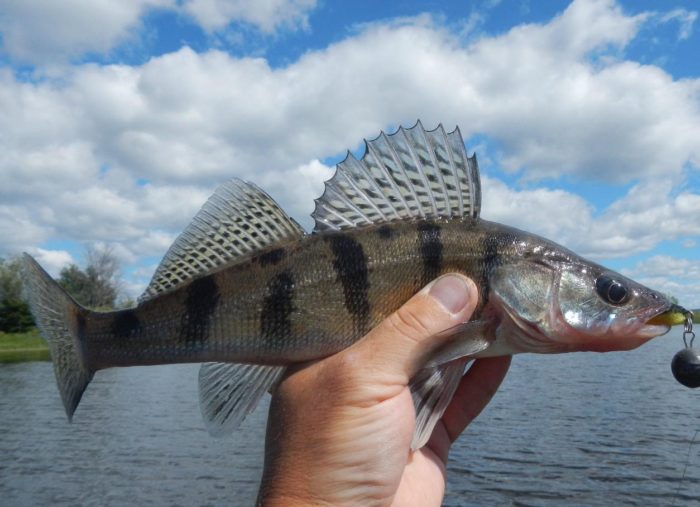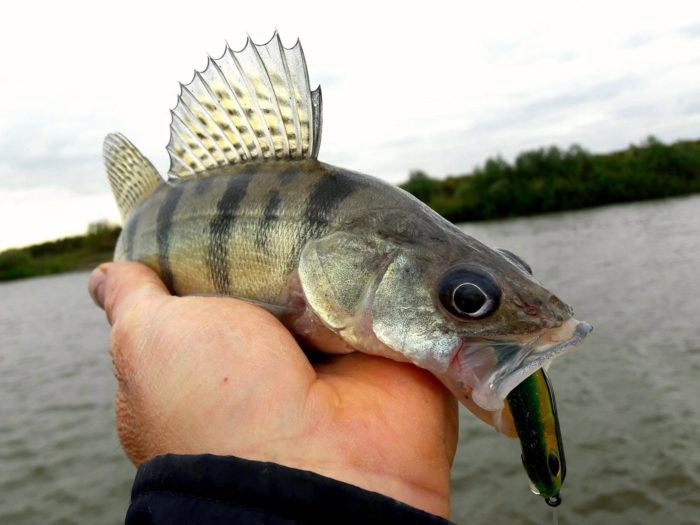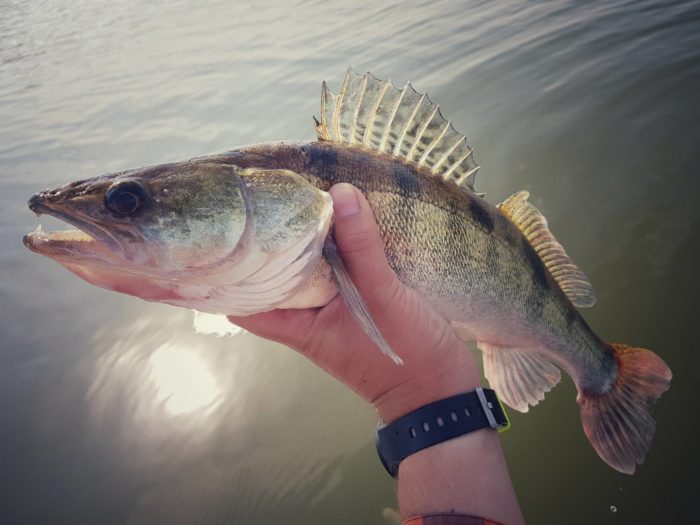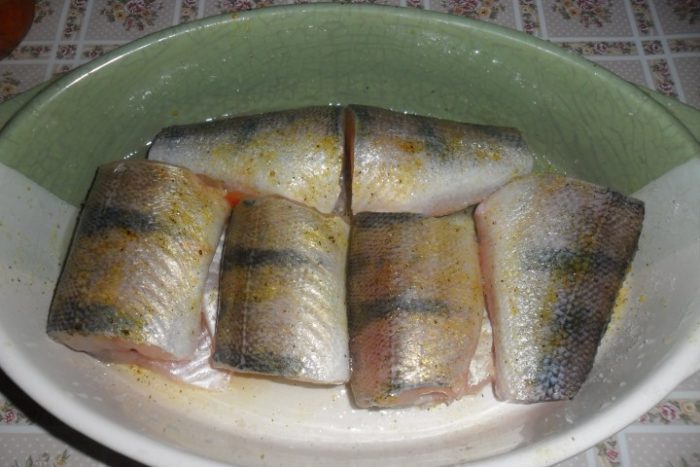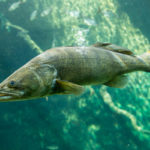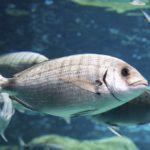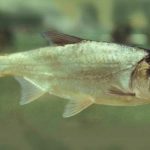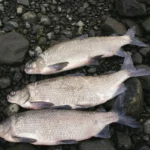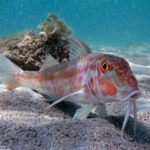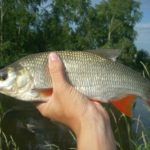The Volga pike perch or bersh belongs to the Okunev family and lives in fresh water bodies. This is not a game fish like regular pike perch, but its meat is a juicy and tender delicacy. Catching bersh requires skill. In addition, it can be confused with pike perch. Bersh fish also swim in schools and feed on other fish. Young animals often stay close to concentrations of pike perch. It is easy to distinguish two representatives of the same family by external characteristics.
What kind of fish is this
Bersh is a typical representative of the Russian water world.Outwardly, it is closer to the perch, but in the structure of the fins and body shape there are similarities with pike perch. The fish has no commercial value due to its small size, but is considered a worthy trophy in sport fishing.
Most often, bersh is found in the Volga basin, hence its second name - Volga pike perch.
How does she look
The compact fish almost fits in the palm of your hand, only the tail hangs down. The bersh has two large dorsal fins and one wide one on the belly. The anterior membranous fins are connected by bony spines.
Signs of the Volga pike perch:
- smooth light scales;
- dark transverse stripes;
- rounded muzzle;
- big eyes;
- small teeth.
Mini-pike perch bersh combines the external features of ordinary pike perch and perch. But it has significant differences from its relatives.
Habitats
Bersch is a freshwater fish and rarely swims out of river channels into the sea. From late spring to early autumn, the fish prefers to stay on the sandy bottom. In winter, she hides in places where there are a lot of snags. In summer, bersha fry swim near the shore, and adult individuals go to a depth of up to forty meters.
The fish lives in Volga reservoirs, where the water flow is slow. Bersh is also found in the beds of the Don, Ural and other rivers flowing into the Caspian and Black Seas. Populations of Volga pike perch were noticed in the tributaries and bed of the Kuban River.
Bersh loves clean water with a moderate current, saturated with oxygen. Therefore, it is not found in muddy, swampy waters.
Lifestyle
Bersh fish is similar in habits to pike perch. Its diet consists of small fish, bottom crustaceans, and fry. Volga pike perch most often hunts for bleak and minnows. It has a narrow throat, so it is no longer possible to swallow larger fish.
Bersh chooses his prey according to size. A hunter 30 centimeters long will swallow an 8-centimeter prey.A larger Volga zander will be tough on a fish ten centimeters long.
Bershis actively feed during the day. A whole flock takes part in the hunt. Large individuals rise to the middle of the riverbed.
Reproduction
Volga pike perch reach sexual maturity in the fourth year of life. Spawning time occurs in the spring, when the water warms up to +10 degrees and above, approximately from April to May. The female lays eggs in shallow water, having previously built a nest at the roots of coastal thickets or in snags. The male guards the clutch until the fry hatch.
How fertile a bersha is can be judged by the size of the nest. One clutch can contain up to five hundred thousand tiny yellowish eggs. They ripen within seven days.
In the first days, newborn fry do not leave the nest and feed on broken eggs. After five days, the grown-up bershiks begin to hunt plankton, and then the fry of other fish species.
Comparison with zander
The pike perch has a muzzle and body shape that resembles a pike. Bersh looks miniature and has smoother shapes and a miniature size. Main similarities and differences between fish:
| Sign | Zander | Bersh |
| Class | Ray-finned | |
| Family | Perch | |
| Length | More than a meter | 45 centimeters |
| Weight | 10-15 kilograms | 1.2-2.9 kilograms |
| Structure of teeth | There are fangs | No fangs |
| Head shape | Narrow long | Short wide |
| Scales | Small, absent on gills | Large, covers gills |
| Lifestyle | Predators | |
| Habitat |
Rivers flowing into the Caspian, Black and Azov Seas, found in the Caspian salt waters. |
|
| Lakes Issyk-Kul in Kyrgyzstan, Balkhash in Kazakhstan, fresh rivers and lakes of Asia and Eastern Europe, rivers of the Baltic and Aral Seas. | ||
Bersh has a lighter color and fewer stripes. Pike perch holds prey with its fangs, so it hunts large bulls and minnows. Bersh prefers small fish, and in case of danger it seeks shelter or clings to the bottom with its mouth.
About fishing for bersha
Volga pike perch is caught throughout the year, day and night. Most often it swims in clean running waters. A good hint for a fisherman where to look for him would be to know the places where ordinary pike perch congregate. Bersh will be located downstream and 8 meters deeper. Its bite is sharper than that of its commercial relative.
Volga pike perch can be caught from the shore or from a boat, but it is important to remember that it looks for food near the bottom. It is caught using float rods and donks. Spoons are used as bait, and live bait is used for bait.
Features of catching bersh in various ways:
- spinning rod is the most effective and versatile, suitable for winter and summer, for boats and fishing from the shore. The optimal length of the spinning rod is 2.7 meters, light class, with a spinning reel and braided line with a diameter of 0.12 millimeters. For spinning, it is better to use artificial bait - a spinner, a silicone vibrotail or worm, a foam fish;
- float rod - for fishing from the shore, a rod 5-6 meters long, a fishing line with a diameter of 0.3 millimeters, hooks with short or long shanks number 6 and 8 are suitable. Bersh is caught with caddis flies, worms, bloodworms, and white maggots. In order for the bait to sink to the desired depth, you will need a pear- or ball-shaped sinker. For fishing from a boat, use a shorter rod;
- mugs - the method is suitable for boat fishing. The diameter of the circle is 150 millimeters, the fishing line is 0.4 millimeters. For bait they use bleak, roach, and gudgeon.It is convenient to catch bersh with mugs where the bottom has a complex topography;
- hook - a hook and sinker are attached to the end of a fishing line, which is wound on a reel or reel. The thrower is thrown into the water from the shore by hand. For this fishing method, a strong fishing line 0.4 millimeters in diameter is used. A worm or sprat is placed on the hook.
Another way to catch Volga pike perch from a boat is called plumb-line - using a short spinning rod or an onboard fishing rod 60-120 centimeters long. To attract fish, a spoon is lowered to the bottom, and small fish and worms are used as bait.
Spring fishing brings the most catch. When the water temperature rises in May, the bersh begins to eat before spawning. After spawning in June, the Volga pike perch also feeds actively. During this period, there is a good bite with all fishing methods. By mid-summer, fish activity decreases.
Beneficial features
Bersha meat is a light dietary product. It is soft and non-greasy, rich in phosphorus and potassium. 100 grams of product contain 18 grams of protein, 2 grams of fat and 80 kilocalories. Vitamins and microelements in Volga pike perch meat:
- calcium;
- iron;
- magnesium;
- zinc;
- selenium;
- B vitamins;
- vitamins A and E;
- Omega fatty acids;
- amino acids.
Bersh dishes are suitable for a recovery diet after surgery or for weight loss. Volga pike perch meat is good for children for growth, immunity, mental development and concentration, as well as the prevention of colds and vision problems.
Regular consumption of fish has a beneficial effect on the body:
- metabolism is normalized;
- toxins are eliminated;
- skin is cleansed;
- tissue regeneration accelerates;
- bones, hair and nails are strengthened.
Eating bersha meat slows down the aging of the female body, prevents hair loss, and helps restore hormonal balance. Thanks to omega fatty acids, men reduce the risk of developing atherosclerosis, diseases of the cardiovascular and reproductive systems.
Volga pike perch meat does not contain carbohydrates, but it contains proteins and amino acids that are useful for strengthening muscles during intense sports training.
Bersha meat dishes can be eaten in moderation during pregnancy and breastfeeding. It contains folic acid, which is beneficial for fetal development. It is enough to include fish 2-3 times in the weekly menu from the second week after the birth of the child.
What are the recipes?
Bersh is prepared in the same way as pike perch: boiled, fried in a pan and grilled, baked with vegetables and cheese, salted and dried. Minced meat is used to make cutlets and pie filling. The fish is easily cleaned of scales.
Bersh meat is less rich in taste than pike perch, but contains fewer small bones. Fish is served with vegetables, cereals, and sauces. Volga pike perch is excellent for preparing traditional fisherman's soup.
Bersh soup
In addition to fillets, heads are used for cooking to make the broth rich.
Ingredients:
- one fish with a head weighing 500 grams;
- 2 separate heads;
- 1 onion;
- 3 potato tubers;
- one carrot;
- half a lemon;
- a bunch of parsley;
- 3 liters of water;
- 2 bay leaves;
- black pepper, salt to taste.
Before cooking, you need to cut off the head, tail, fins of a whole fish, remove its scales and entrails, and then separate the fillet. The heads, including those separated from the fish, must be washed. Eyes and gills add bitterness to the broth, so it is better to cut them out.
Method for preparing fish soup:
- Place the heads, fins, ridge and tail in a saucepan, add water and cook for 40 minutes over medium heat;
- cut the fillet into pieces, sprinkle with pepper and salt, pour over lemon juice;
- chop half a bunch of parsley, sprinkle the fillet with herbs;
- cut the peeled onion into cubes, also add to the fish and leave it to marinate for 40 minutes;
- peel potatoes and carrots, cut into cubes;
- Strain the finished broth into a clean saucepan, add vegetables and cook for 15 minutes over moderate heat;
- pour the bersha fillet into the ear along with the marinade, add bay leaf, more salt and spices as desired;
- After 10 minutes the ear is ready.
The Rostov version of the dish includes tomatoes, parsley root and butter. Peeled whole onions and roots are placed in boiling broth and simmered over low heat for 35 minutes. It turns out transparent.
Then the chopped onion and root are added to the strained broth with potatoes and carrots. Five minutes before the dish is ready, add two diced tomatoes without skins to the pan. Both recipes for Volga pike perch soup are suitable for cooking over a fire.
Fried berche with sesame seeds
Sesame seeds are an original replacement for the boring breading of breadcrumbs and flour. Fried fish prepared according to this recipe acquires a pleasant aroma and unusual taste.
Ingredients:
- 500 grams of bersha fillet;
- 30 grams of sesame seeds;
- a tablespoon of lemon juice;
- coarse sea salt, ground black pepper to taste.
To fry fish in a frying pan, you will need vegetable oil - sunflower or olive. Cooking method:
- cut the fillet into strips;
- salt, pepper, sprinkle with lemon juice;
- let it brew for 15 minutes;
- heat oil in a frying pan;
- pour sesame seeds into a separate bowl;
- roll fish pieces in seeds and place in a heated frying pan;
- fry the fillet over high heat for 5 minutes on each side.
You can add 2-3 drops of vegetable oil to the marinade with seasonings and lemon juice to make the bersh more juicy. Serve the finished fish with a side dish of mashed potatoes or vegetable salad.
Bersh Mediterranean style
Fish cooked in this way becomes juicy and tender. In Mediterranean cuisine, sea bream is baked according to this recipe.
Ingredients:
- a Volga pike-perch fish weighing one kilogram;
- zest of one lemon;
- a small bunch of dill and parsley;
- 50 grams of butter;
- 1 raw egg white;
- 2 kilograms of regular rock salt.
To bake fish in the oven you will need foil. Bersh must first be cleaned and gutted. Cooking method:
- put the butter to melt in a warm place;
- turn on the oven so that it warms up to 200 degrees;
- mix salt and protein in a bowl;
- Finely chop fresh washed greens;
- mix butter, lemon zest, chopped dill and parsley;
- stuff with spicy bersha mixture;
- cover a baking sheet with two layers of foil, evenly distribute half the salt mixed with the egg white on top;
- Place the fish on the salt layer and cover it with the remaining salt;
- bake for 45 minutes.
To make the protein-salt mixture thick, you can add a little water. The finished fish is served on foil. The hardened salt is broken using a knife and a meat hammer.

